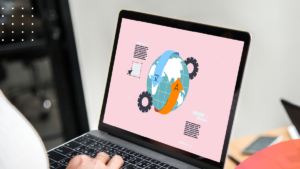How Audiovisual Translation Powered by AI Helps in Business Expansion

The global spread of streaming services creates new demands for content creators, who need localisation services to help their videos reach international audiences. At the same time, this need to increase the number of available languages brings new opportunities and challenges for translators, who move in an environment that is constantly changing and introducing new rules into the game. The use of AI in audiovisual translation is one of the latest trends, as it provides fast results by trimming some stages of the traditional translation process.
This blog will take an in-depth look at the benefits of using AI to go global and its advantages for your video strategy.
First Approach: What Are AVT and AI?
Audiovisual Translation (AVT)
Audiovisual translation is the transfer from one language to another of the spoken texts in multimedia productions, such as films, documentaries, video games, etc. It also includes the localisation of visual elements on display that may influence the story’s development. The main techniques are: subtitling for audiovisual translation and voice dubbing.
Artificial Intelligence (AI)
Artificial intelligence is the ability to endow machines and programs with human thinking; that is, they can behave intelligently to analyse, learn, reason logically, and solve problems. This means they can formulate predictions automatically, quickly, and accurately.
#OptimationalTip: If your marketing strategy includes interactive or streaming content, you should start with a multilingual translation as the next step. With a qualified audiovisual translation, you will speak your customers’ language and engage them with your content.
Uses of AI for Audiovisual Translation
How Does AI Interact with AVT?
In the world of translation, AI emerges in the form of machine translation. The most popular worldwide is Google Translate, which paved the way for other similar types of software entering the market. Originally, linguistic exchange was performed word by word, which frequently resulted in incoherent and even funny texts.
In recent years, however, machines have been producing better translations by including context elements relevant to the meaning. Thus, the AI mimics human brain functions that link concepts and use the Internet as a terminological base.
How Does AVT Benefit From AI?
AI can help companies increase productivity since it can quickly translate conversations, voice-off and voice-over speeches, etc. Thus, companies can, instead, focus their attention on further stages of their strategy to go global.
The role of humans in audiovisual translation will not disappear, though. It will instead shift to an editing and quality control role. In other words, this technology will not replace professional translators. What AI brings is a collaboration between the translator and the machine, which optimises times while ensuring accuracy.
#OptimationalTip: Although AI offers you quick and almost cost-free translations, not relying on a professional service for quality control is a big risk that could cost you a lot. Use the benefits of AI wisely.
The Value of Efficient Collaboration to Benefit Your Business
Now that you have seen some of the advantages of AI, let us take a closer look at the reasons why using the machine alone will not be enough to produce a professional audiovisual translation.
- Voice and style of the characters: Can you imagine how confusing and monotonous it can be to translate all speeches in the same manner? Each person has their unique way of communicating, and the subtitles must reflect this essence—including the use of slang.
- Intention: The purpose of what a character says is vital. The machine can hardly distinguish whether someone is simply speaking informatively or with a specific intention—for example, sarcasm.
- Proverbs and idioms: Every culture has its common sayings, metaphors, and analogies. A literal translation may not achieve the desired effect and could even confuse the spectators.
- Context: While AI uses the context of the whole text to translate, it lacks visual and auditory information to clarify specific communicative situations.
- Specialised texts: Just as there is spoken content with a common language—suitable for all audiences—there are also specialised videos. For instance, in a medicine documentary, it is natural to expect the use of scientific terms.
#OptimationalTip: If your content also includes proper SEO, you should entrust the audiovisual translation to a professional who will ensure an appropriate localisation based on your strategy.
Final Thoughts
Over time, AI will become more efficient and capable of delivering better translations, helping your business expand overseas. However, as the human voice is ever-changing, emotional, and strongly influenced by its culture, the role of the human translator will remain necessary for your business to preserve a professional reputation.
If the audiovisual translation of your content is the next step to go global, contact us today. We have the solution you need.


